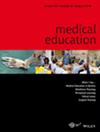Tolerance of ambiguity and psychological wellbeing in newly qualified doctors: An analysis over multiple time points
Abstract
Introduction
There is evidence of an association between tolerance of ambiguity and psychological wellbeing in doctors, but this relationship is not well understood. We explored this relationship, and the individual or workplace factors moderating it, in a population of newly qualified doctors.
Methods
We examined the experiences of newly qualified doctors in the UK as they started a novel interim role (Time 1) and later moved into foundation year 1 roles (Times 2 and 3) during the COVID-19 pandemic. Doctors completed the Tolerance of Ambiguity of Medical Students and Doctors scale (TAMSAD Range: 0–100), the Perceived Stress Scale (PSS: 0–40), the Hospital Anxiety and Depression Scale (HADS: 0–21) and the Copenhagen Burnout Inventory (CBI: 0–100), over four months. Cross-sectional and longitudinal relationships between tolerance of ambiguity (TAMSAD) and wellbeing outcomes (PSS, HADS, CBI) were examined and potential moderators (age, gender, recent change in working environment) were explored.
Results
A total of 451 participants completed the survey at Time 1, 214 at Time 2, 172 at Time 3. Higher tolerance of ambiguity was associated with lower levels of stress (regression coefficient: -0.09, R2 = 1.6%, p = 0.008), anxiety (−0.06, R2 = 1.6%, p = 0.009), depression (−0.03, R2 = 1.1%, p = 0.03) and workplace burnout (−0.40, R2 = 3.9%, p < 0.001) at Time 1. It was associated with lower levels of anxiety (−0.08, R2 = 2.4%, p = 0.03) at Time 2 and stress (−0.16, R2 = 3.4%, p = 0.02) at Time 3. Individual factors (being over 25 years, being female) and workplace factors (not moving location) seemed to strengthen the relationship between tolerance of ambiguity and psychological wellbeing.
Conclusion
There appears to be a longitudinal relationship between lower tolerance of ambiguity and reduced psychological wellbeing in early career doctors within the UK. This study emphasises the importance of supporting all graduating doctors to navigate clinical ambiguity however further research is needed outside of the context of COVID-19.





 求助内容:
求助内容: 应助结果提醒方式:
应助结果提醒方式:


